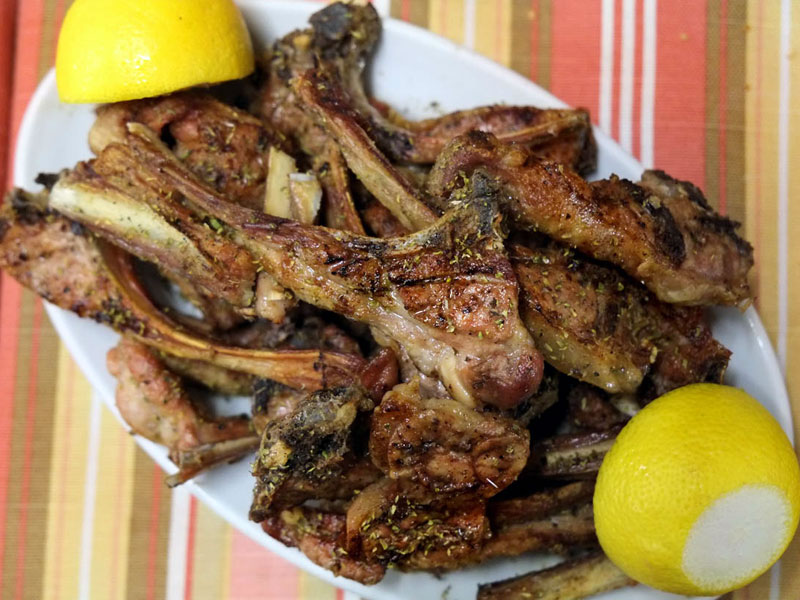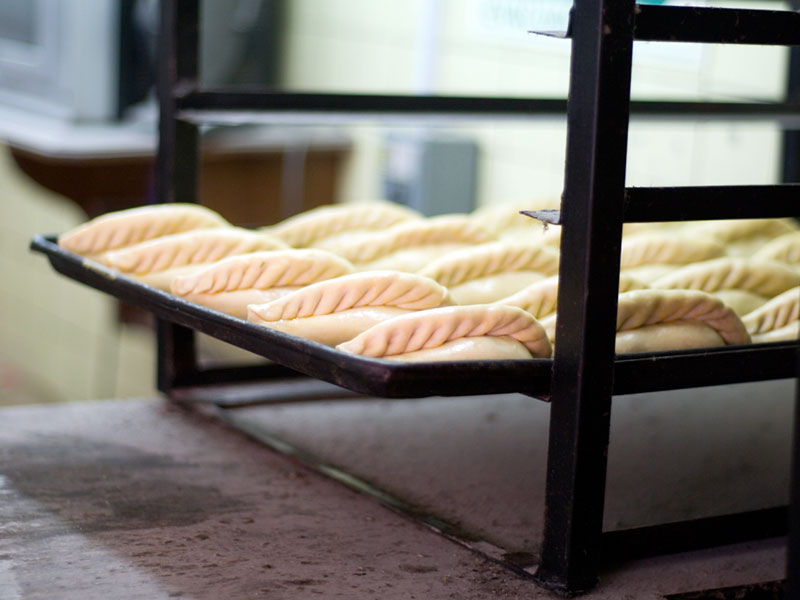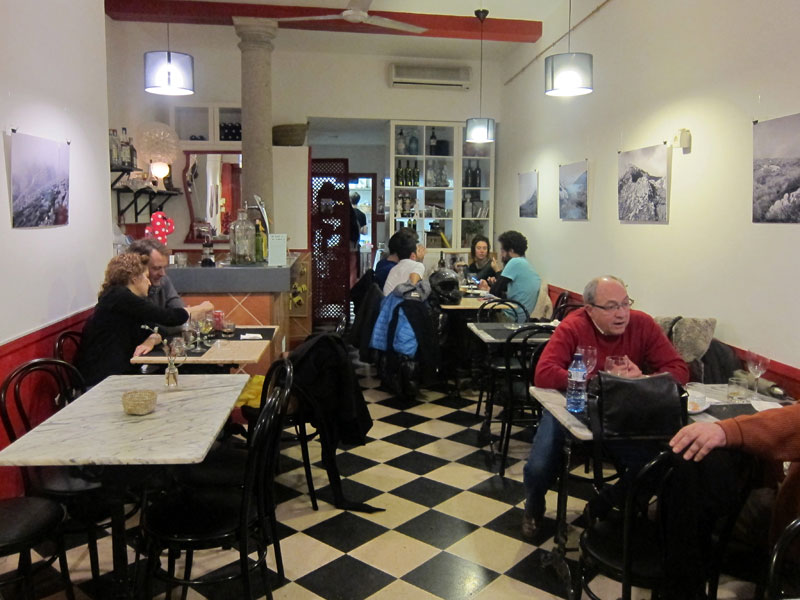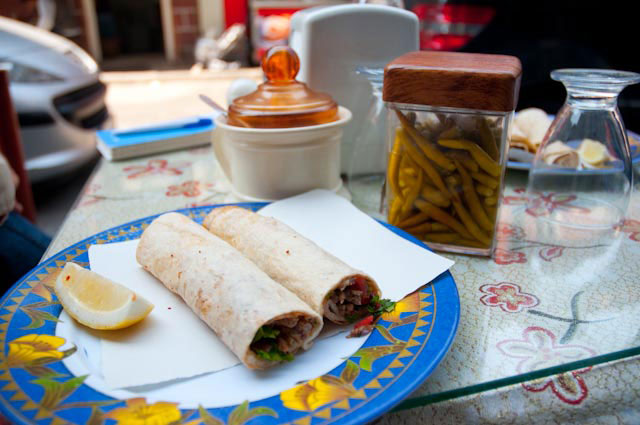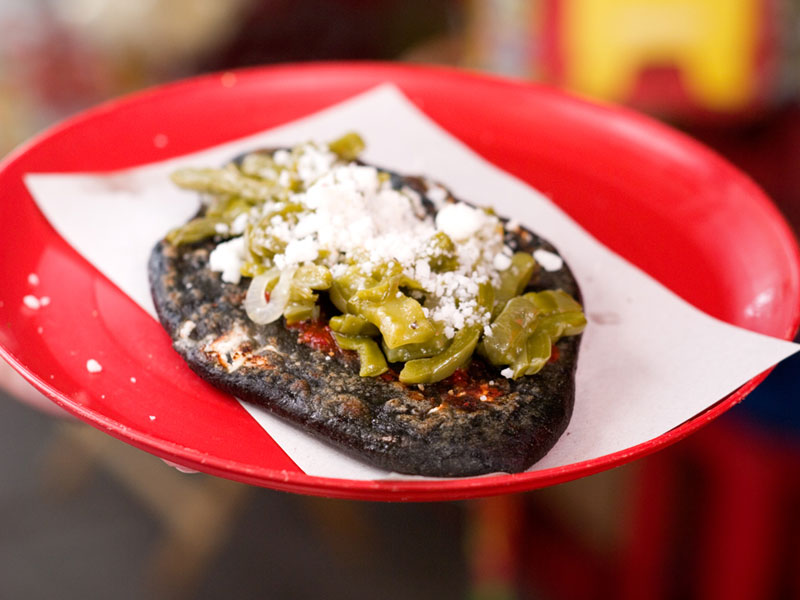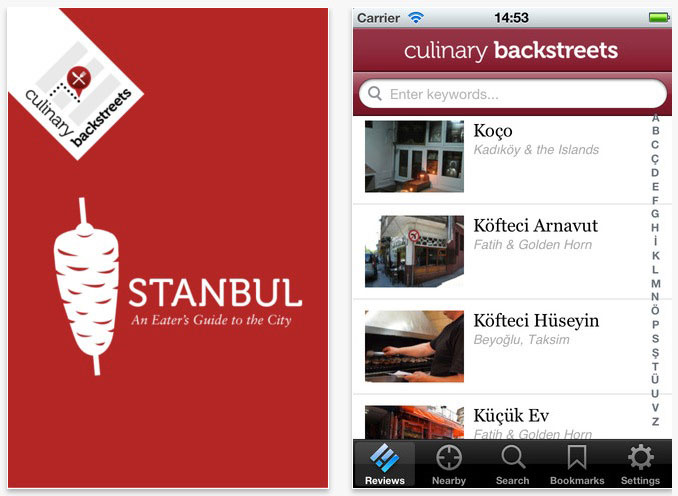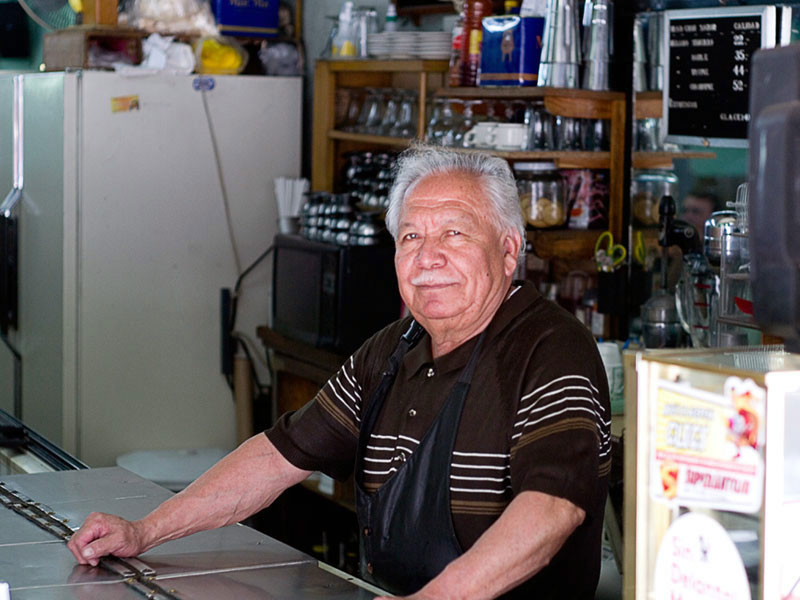We can't find the internet
Attempting to reconnect
Something went wrong!
Hang in there while we get back on track
Search results for
Athens
To Koutouki tou Marathoniti: Underground Chops
Mets is undeniably one of central Athens’ prettiest neighborhoods, a mostly residential area filled with a mix of neoclassical houses, Bauhaus architecture and 1960s-era buildings that is also home to the city’s historic First Cemetery. Legend has it that the neighborhood was named after a beer parlor that was in turn named after the city of Metz in northeastern France. On the periphery of Mets, hidden rather incongruously in the basement of an old building, To Koutouki tou Marathoniti is the kind of place you would never find if you didn’t know it existed.
Read moreShanghai
Ask CB: The Ethics and Politics of Shark Fin Soup?
Dear Culinary Backstreets, I’ve been hearing a lot about shark fin soup in the news lately, from countries banning the dish to people protesting government intervention. What’s all the fuss about? Imagine a wedding without Champagne. No popping corks, no celebratory toasts, no drunkenly giddy bridesmaids. Sounds like a nightmare, right? Shark fin soup is the Chinese equivalent of bubbly – only fermenting grapes has little effect on the environment, while the practice of “finning” has seriously jeopardized the survival of some species of this ancient fish. To harvest the goods, fisherman chop off a shark’s fins, then dump the still-living creature back into the water. Without its fins, the shark cannot swim and either sinks to the bottom of the ocean, where it drowns, or is eaten alive by other predators.
Read moreShanghai
Wei Xiang Zhai: One-Dish Wonder
Sometimes a word in Chinese so perfectly captures a mood or feeling that the English approximation seems woefully inadequate. To take one example, the Chinese combine “hot” (热) and “noise” (闹) to describe the loud and lively nature of local hotspots, but in English, the best we can do is “bustling.” To experience what China’s “hot noise” is really all about, head to Wei Xiang Zhai. Not for the claustrophobic or timid, this wildly popular noodle house demands that you elbow your way to a table for your chance to slurp down a bowl of the city’s best sesame paste noodles (麻酱面, májiàng miàn).
Read moreBarcelona
When the Going Gets Tough, the Catalonians Get Brewing
Once a mostly beer-free country, Spain – traditionally a land of wine drinkers – has recently started to develop a taste for the sudsy beverage, and Catalonians seem to have been the main pioneers behind this growing trend. The number of local craft breweries is increasing and so is the number of beer fans, who are also learning how to brew the drink at home. Put it all together and you have a young and adventurous market that is ready to experiment with tastes and textures to create stellar new beers with a distinct Mediterranean flavor.
Read moreIstanbul
Istanbul’s Top 3 Lahmacun Makers
Lahmacun is one of those mysterious foods where a lot is created with so little. It checks all of the boxes of a perfect savory snack: crispy, oven-fired crust, light and spicy meat spread, a fresh green garnish and a tangy spray from a lemon. It’s like an artisanal pizza with a Middle Eastern topping wrapped around a side salad – for the cost of a shoeshine.
Read moreIstanbul
Gazoz: Turkish Fizzardry
In a 2003 TV commercial for Cola Turka, the actor Chevy Chase was seen speaking Turkish and then sporting a moustache, after taking just one sip of the intended challenger of Coke in this country. This sensational ad – which riffed on the old theme of American cultural imperialism through its number-one agent, Coca-Cola – was the first time that Turkish soft drinks caught our attention. Though we didn’t take to the overly sweet Cola Turka, we did start looking beyond, to its local brethren in the market: gazoz, a world of nearly extinct Turkish carbonated drink brands with a fanatical following.
Read moreMexico City
Pastes Real de Pachuca: Hot Pocket Goldmine
Update: This spot is sadly no longer open. For weeks we had been passing by a small venue that filled the sidewalk with the heavenly scent of butter and pastry dough, before we finally had the chance to stop in and investigate. The source of the intoxicating aroma turned out to be Pastes Real de Pachuca, a neighborhood bakery in middle-class Colonia Tabacalera that makes excellent empanadas and pastes, a type of pastry that’s a specialty of Mexico’s Hidalgo state but hard to find in Mexico City.
Read moreAthens
To Rodi
A quiet residential area in Western Athens, the working-class suburb of Sepolia was until the 1970s characterized by a few industrial buildings, empty plots of land and small, humble houses. Over the past few decades, Sepolia has developed rapidly and is now full of high-rise apartment buildings. Though it still has a neighborhood feel, there aren’t many cafés or dining venues, which makes To Rodi – an Armenian restaurant and neighborhood souvlaki place that does some of the best kebabs in Athens – seem particularly incongruous.
Read moreAthens
Phaleron: Athens’ Culinary Museum of Innocence
Once a resort town on the outskirts of the Greek capital, Phaleron – only a few miles from downtown Athens – is now well incorporated into the city’s urban fabric. The area has remained an upscale neighborhood, but, sadly, it has lost its distinctive character: the sea is now polluted, the open-air cinemas have been turned into parking lots, and many of the stately mansions were demolished to make way for apartment blocks during the construction boom of the 1960s.
Read moreBarcelona
Mercè Vins: Home Away From Office
Editor's Note: Sadly, this spot is now closed. Mercè Vins is exactly between two worlds, located on the quiet, narrow and dark Carrer d’Amargós, close to the shopping area of Portal de l’Àngel, near the Cathedral and Plaça de Sant Jaume, and on the border between the Barrio Gótico and Born neighborhoods, where there are numerous offices and public institutions, filled with employees looking for a breakfast that goes beyond a sad, ersatz “croissant” or for a lunch that approximates the kind of meal they would get if they were able to sneak back home.
Read moreIstanbul
Meşhur Filibe Köftecisi: Keeping Their Eye on the Meatball
Where we come from, flipping burgers is a time-honored tradition among pimply teenagers looking for a summer job and troubled short-order cooks looking for a place to land in between firings. It’s work that promises mobility, not stability. But don’t tell that to Ziver Usta, who’s been turning the köfte – something like Turkey’s equivalent of the hamburger – at the grill of the shoe-box-sized Meşhur Filibe Köftecisi in Sirkeci for the last 30 years. The dough-faced Ziver, in his early fifties, is actually the restaurant’s junior employee – “head waiter” Mehmet has been there for 40 years – but his long tenure means he’s only one of a select handful of grill masters who have worked at Filibe over the course of its 100-year history.
Read moreMexico City
El Profe: Barbacoa Master Class
One of our favorite markets in Mexico City, Mercado Jamaica is a fantastic destination any time of the year, offering everything from festive Christmas decorations to a large selection of fruits and vegetables. After the markets of Xochimilco, Jamaica is also one of the city’s best flower markets, with block-long aisles filled with freshly cut flowers and plants of almost every imaginable color and type. But as much as we love getting lost in the sweet scents of these green alleyways, what keeps us coming back to Jamaica is El Profe, an excellent eatery inside the market that specializes in barbacoa. El Profe ("The Prof") looks less like your typical market food stand and more like a mini restaurant, with small brass chandeliers hanging from the ceiling that provide more in the way of ambiance than actual light. Waiters and cooks in matching blue uniforms hustle and bustle around the customers, who come and go from the counter at a steady pace.
Read moreAthens
Ask CB: Greek Coffee in Athens?
Dear Culinary Backstreets, I keep hearing about Greek coffee but is it any different from Turkish coffee? And do most Greeks actually drink Greek coffee these days or do they drink other types of coffee? Greek coffee is exactly the same as Turkish coffee – and it was in fact called just that in Greece until Turkey invaded Cyprus in 1974, at which point, for political reasons, the Greeks decided to rename their coffee “Greek coffee.” The process and preparation, though, are identical to the Turkish way.
Read moreIstanbul
Istanbul’s Burger Battle Goes International
Update: Shake shack and Fatburger are sadly no longer open. As chronicled by Istanbul Eats, the Tünel end of Istanbul’s famed İstiklal boulevard was some two years ago the site of a heated burger war. It all started when a former Turkish basketball-player-turned-restaurateur who had spent time studying in California opened up Mano Burger, a mostly successful recreation of the kind of burger joints the owner frequented in the United States.
Read moreAthens
Athens’ New-School Wine Bars
The economic crisis that has plagued Greece for the past five years has led to changes on the Athenian culinary scene, including the opening of three new types of venues that seem to be reflective of the times. The first two – cupcake places and frozen yogurt shops – are imports from abroad, perhaps indicative of a population in need of something sweet, comforting and affordable. On the other hand, the third trend, wine bars, digs deep into Greece’s roots, representing a fascinating phenomenon in a country that is one of the world’s oldest wine-producing regions. In antiquity Greek wine was exported across the Mediterranean, and the winemaking tradition has remained strong through the millennia. Yet although there are numerous wineries around the country, in the modern era Greek wine has never achieved the place it deserves on the international market. Production levels are low and vintners have long been unsure of how to market abroad.
Read moreMexico City
Coox Hanal: Peninsular Gastronomy
The holiday season is one of the more subdued times of the year in Mexico City. Many people leave the city for vacation or to visit family and friends in other parts of the country. We, however, tend to stick around more often than not, traveling around the city and enjoying the relative peace. That’s how we happened upon Coox Hanal, a restaurant hidden inside a century-old building in the Centro Histórico that specializes in the cuisine of the Yucatán, the peninsula that juts out into the Gulf of Mexico and the Caribbean Sea like a hitchhiker’s thumb.
Read moreBarcelona
Barcelona’s Restaurants Go Underground
At Culinary Backstreets, we are all about seeking out backstreets eating at venues serving authentic cuisine and frequented mainly by locals – an approach that usually leads both to delicious food and to prices that won’t break the bank. But how about underground dining, where even locals themselves aren’t always in on the secret?
Read moreIstanbul
Mustafa Amca: Soul Proprietor
The Turkish proverb “At, avrat, silah ödünç verilmez” (“neither horse, wife nor weapon should be lent”) is sometimes repeated as a way to recall the nomadic warrior past of the Turks. The primal Turkish essentials are clearly stated, but what about the çay bardağı, the tea glass that has become such a ubiquitous Turkish icon? Reading the 17th-century works of Evliya Çelebi, the Ottoman Rick Steves, you’d expect to find descriptions of medieval tea jockeys swinging trays filled with those tulip-shaped glasses through the alleyways of the Old City. Right?
Read moreShanghai
Enter the Snake: Eating Your Way to a Happy New Year
As the moon starts to wane each January, people throughout China frantically snatch up train and bus tickets, eager to start the return journey to their hometown to celebrate the Lunar New Year (春节, chūnjié) with their family. One of the major draws for migrant workers heading home is the chance to eat traditional, home-cooked meals.
Read moreAthens
Red Elephant: Move Over, Souvlaki
The first wave of Indian, Pakistani and Bangladeshi immigrants arrived in Athens in the early 2000s, bringing a new eating culture with them. This was a time of prosperity in Greece and consequently the first South Asian restaurants, such as the now-defunct Pak Indian, were welcomed with open arms by Greeks who were willing to experiment. It helped that an enormous number of young Greeks had studied abroad in the 1990s and early 2000s, mainly in the United Kingdom, where they were introduced to the cuisine of the Subcontinent.
Read moreBarcelona
Na Mindona: Island Style
When Xisca Ferragut left Mallorca (the largest of the Balearic Islands, located in the Mediterranean Sea off the eastern coast of Spain) and moved to Barcelona, she had no intention of opening a restaurant. Having lost her job back in Mallorca, she had decided to study sign language and become an interpreter. Then her boyfriend, Dionis Ballester, showed up and as the two struggled to find work, they noticed something: there were literally NO Mallorcan restaurants in Barcelona.
Read moreIstanbul
Beşaltı Kirvem Tantuni: Turkish for “Taquería”?
One of the big downsides to Istanbul’s otherwise great food scene is the lack of a credible Mexican option. We’re not asking for anything special, just a place that serves simple, tasty tacos or burritos. But when the craving for Mexican gets strong, we don’t despair; we just head down to the waterside neighborhood of Karaköy, home to Beşaltı Kirvem Tantuni, a hole-in-the-wall (literally) spot whose food and atmosphere remind us of the tiny taquerías in Mexico and the United States that we miss so much.
Read moreBarcelona
Calçots: Not Your Average Onion
As the legend goes, a 19th-century Catalan farmer was out experimenting in his fields when he came up with a new kind of longer, juicier green onion, the calçot. In creating the onion, the farmer produced much more than a new vegetable; he also paved the way for the rise of an idiosyncratic, and distinctly Catalan, cultural event.
Read moreMexico City
La Central de Abasto: Wholesale City
The first time I tried to photograph La Central de Abasto in Mexico City, it was without permission, which was utterly impossible. As I walked through the market’s immense corridors, every time I tried to get a shot I would begin to hear cackles and whistles from the vendors. Their chatter had a signature sound like a backwards catcall and it traveled through the high market rafters from one stand to another, like birds squawking in the treetops through a vast forest. This alarm would consequently bring a plain-clothes security guard, who blocked my passage and asked me to show my permission papers to take pictures. When I could produce nothing, I was escorted sternly and quickly outside the market doors. I tried my luck at shooting in another section of the market but, yet again, a rising whistle would start and another security guy would appear and cut me off. I gave up.
Read moreIstanbul
The Simits Take Manhattan
Being big fans of simit – the sesame-encrusted bread ring that’s one of Turkey’s most popular street foods – we’ve looked on with delight over the last few years as the humble snack has made its way from Istanbul to the other metropolis with a 212 area code: Manhattan. First, longstanding Istanbul baklava maker Güllüoğlu opened a branch in Midtown East and began selling freshly baked simit under the moniker “Turkish bagel.”
Read moreShanghai
Jian Guo 328: The Great Indoors
In Shanghai, there’s a time and a place for taking part in the city’s rough-and-tumble street food scene, but sometimes you want to eat out knowing that your bowl of noodles will not accidentally become someone’s ashtray or that you don’t have to elbow an elderly lady out of the way for a seat. Somewhere between the dive noodle stalls and the elegant confines of the city’s upscale banquet-style restaurants lies the holy grail of eating authentically: affordable local cuisine in a non-smoking, no grime, no-nonsense environment – with painted walls to boot! Meet the popular Shanghainese restaurant Jian Guo 328.
Read moreMexico City
In Praise of the Fonda, Mexico’s Mom & Pop Restaurant
For as long as I can remember, I have loved mornings, a preference that likely – perhaps counterintuitively – originates from my experience working bright and early at my parents’ fonda. Almost every day, we would arrive around 7 a.m. to prepare the day’s menu, slicing vegetables for salsas, putting together moles, boiling chicken and arranging everything necessary for the daily rush of customers. The warmth and aromas rising from the large clay pots filled the air and never failed to make my mouth water. It was a scene that had been repeating itself since my grandfather bought our fonda back in the early 1960s.
Read moreAthens
To Petalo: All-You-Can-Eat Authenticity
To Petalo is probably the only place in Athens that offers a Sunday lunchtime buffet with homemade Greek food. It’s certainly the only all-you-can-eat brunch we know of that’s offered at the affordable price of €12, in a cozy yet slightly chaotic atmosphere that makes you feel like you’re eating in someone’s living room. And just as if you were at the house of a Greek friend, brunch at To Petalo is served in typically late fashion: Arrive before 2 p.m. and you’ll be waiting around for the food to be served.
Read moreBarcelona
Ask CB: Tortilla Española in Barcelona?
Dear Culinary Backstreets, In just about every restaurant or bar I’ve been to in Barcelona, I’ve seen a dish called “tortilla.” What exactly is a tortilla and can you recommend any places where they are done especially well? Although it would seem that much of the world imagines the inhabitants of Spain subsisting largely on paella, the truth of the matter is that it is the tortilla española, also known as tortilla de patatas (truita de patata in Catalan), that really holds the place of honor in the hearts and stomachs of Spaniards. Often translated into English on menus as “potato omelet,” this hearty round cake of potatoes, eggs, olive oil and salt has nothing to do with the traditional French omelet, nor does it have anything in common with a Mexican tortilla. At its most basic, the Spanish tortilla is made by frying up a thick mass of sliced potatoes and eggs in olive oil and then slicing it into savory wedges.
Read moreShanghai
Hai Di Lao: Serve the People (Manicures Included)
Good service in China is a relative term, and the longer you live here, the lower your expectations sink. The Michelin Guide allegedly won’t deign to cross over the Hong Kong border into China because they refuse to sully their white-tablecloth reputation by doling out stars to restaurants with subpar service. But the inspectors must have never entered a Hai Di Lao Hot Pot, or they might have to change their tune.
Read moreIstanbul
Istanbul's Top 5 Beaneries
Until we visited some of Istanbul’s shrines to the baked bean, we generally regarded the dish as something eaten out of a can beside railroad tracks. But Turkey takes this humble food, known as kuru fasulye, seriously; that means chefs in tall toques carefully ladling out golden beans in a rich red gravy onto monogrammed flatware, served by waiters wearing bowties and vests. Even in the least formal of Istanbul’s beaneries, the guy manning the pot has the air of a high priest who knows that his incantations alone conjure something unusually delicious out of a simple dry white legume. This is no hobo fare.
Read moreBarcelona
Baluard: Bakery Rising
Spain has not traditionally been known as a country of great bread, although there are some exceptional old tahonas (bakeries) scattered around here and there. But after long decades of eating poor-quality breads, typically white or light bread with excessive additives, Spaniards are finally developing their taste for the staple. In fact, the culture of bread in Spain is in full fermentation right now.
Read moreIstanbul
On the Anchovy Trail
We are unabashedly fanatical in our love of hamsi, or anchovies, a late fall/wintertime specialty whose arrival we eagerly await each year in Istanbul, where the tiny fish are most commonly served pan-fried, grilled or in pilaf. But as any hamsi aficionado knows, for the best anchovy-eating in Turkey one must go directly to their source: the country’s Black Sea coastline, where the catch is brought in.
Read moreMexico City
Sullivan Market: Food Vendor Bender
Markets in Mexico City are as integral a part of the culture as mariachi music and tacos, providing a place for neighbors to come together for shopping, gossip and family outings and playing a key role in keeping the social fabric tightly woven. While most neighborhoods have their own brick-and-mortar locations, their street markets are far more colorful. These crowded, boisterous shopping areas – some so large that their colorful tarp roofs can been seen on satellite photographs, stretching for miles – are also an essential component of the city’s culinary scene.
Read moreIstanbul
CB’s First App in Saveur’s Top 100!
We are proud to announce that Saveur has included the Culinary Backstreets: Istanbul iPhone app in its “Saveur 100: Travel Edition” list, published in the magazine’s January/February 2013 issue. Saveur praised the app’s “smart search functions, integrated maps and vivid photos,” calling it “the ideal portable portal to one of our all-time favorite food cities.” This recognition comes just months after our sister website, IstanbulEats.com, won Saveur’s “Best Culinary Travel Blog” award in 2012.
Read moreBarcelona
Bagauda: Northern Comfort
Editor's Note: Sadly, this spot is now closed. Everyone knows that Germany and France can both make a mean loaf of bread. But what about Spain? When was the last time you heard someone say something like, “What this meal really needs is some delicious Spanish bread!” You’ve never heard anyone say that and the reason is that the bread in Spain is, with few exceptions, decidedly mediocre, with even the smallest bakeries producing the majority of their “fresh-baked” product using partially baked or frozen dough made in factories using industrial yeasts and preservatives.
Read moreIstanbul
Ask CB: Flyby Dining in Istanbul?
Dear Culinary Backstreets, I’ll have an eight-hour layover in Istanbul and was wondering if you have any suggestions for places to go for a good Turkish breakfast and lunch. I love to eat at small, local places serving authentic food. I would prefer restaurants in the Yeşilköy area, as I have to be back at Atatürk Airport to board an international flight (which I cannot afford to miss!).
Read moreShanghai
Da Hu Chun: Nice Buns
To qualify as a Chinese Time-Honored Brand (老字号, lǎozìhào), shops must prove that they’ve been a profitable business since 1956. Only about 1,000 brands across the country have achieved this honor, an impressive number considering the tumult of the last 60 years in China and the damage to hundreds of historical national treasures. Among these government-endorsed venues is Da Hu Chun (大壶春), one of Shanghai’s oldest fried pork bun shops, which first opened in the 1930s, less than a decade after its specialty dish, shēngjiān mántou (生煎馒头), was created.
Read moreAthens
Ask CB: Vegetarian Eating in Athens?
Dear Culinary Backstreets, Both my husband and I are vegetarian and we are planning a trip to Athens. We’ve heard that Athens doesn’t have a lot of choices for vegetarians and are a bit worried. Will it be possible for us to eat some of that lovely Greek food? What kind of traditional vegetarian dishes would you suggest we try?
Read moreIstanbul
Best Bites of 2012: Istanbul
After four years of publishing weekly dispatches from Istanbul’s culinary backstreets (on IstanbulEats.com and now on this site as well), we are still regularly surprised by new discoveries, impressed by the staying power of old standards and shocked by how quickly so much can change. For better or for worse, it is that dynamism that Istanbulites line up for, and the city never seems to run short on it. Heading into 2013, we are licking our chops in anticipation of the expected and the unexpected, which are always sure to be delicious, or at least interesting. Here are our Best Bites of 2012.
Read moreBarcelona
Best Bites of 2012: Barcelona
Editor’s note: This is the penultimate installment of “Best Bites of 2012,” a roundup of our top culinary experiences over the last year. Stay tuned for our final “Best Bites” dispatch, from Istanbul, tomorrow. Restaurant Roma We hadn’t planned on bringing in La Nochevieja at Restaurant Roma, but it was nearby and we didn’t feel up for public-transport adventures on New Year’s Eve. Situated on a quiet street in the upscale but untouristy Barcelona neighborhood of Sant Gervasi, Roma is thoroughly nondescript – a neighborhood joint frequented by neighborhood people of a certain age. The wood-paneled walls, racks of Maxim magazines and TV mounted in the corner kept our expectations pretty low.
Read moreMexico City
Best Bites of 2012: Mexico City
The past year has been a very good one for food in Mexico City. We’ve had a wonderful time exploring new restaurants, tracking down exciting dishes and meeting great people along the way. There have been so many memorable moments over the past year that it was hard to sit down and come up with a list of the ones that really stood out the most. Through debate and discussion (and some revisits), we narrowed down the worthy field to our top favorites. Here are our Best Bites of 2012 from Mexico City. El Pozole de Moctezuma First up on our best food experiences of the year would have to be the pozole at El Pozole de Moctezuma. Located near Metro Garibaldi, the building is nondescript and shows no sign of the deliciousness that lies within, so if we hadn’t been taken there by a friend, we never would have known about it. But what a discovery! The friendly staff showed us exactly how to build the perfect bowl of pozole, from choosing the color and flavor of the broth to adding oregano, chili powder, lime juice and, of course, a splash of mezcal. A bowl of soup never tasted so good or filled us up more satisfyingly than that at El Pozole de Moctezuma. Best of all, the place is a long-term neighborhood fixture that celebrated its 65th anniversary in 2012, a fact that bodes well for future visits.
Read moreAthens
Best Bites of 2012: Athens
Editor’s note: This is the second installment of “Best Bites of 2012,” a roundup of our top culinary experiences over the last year. Up next is Mexico City. Oinoscent Greek wine has always been a bit of a hidden gem, excellent but produced in small quantities and thus more expensive when exported; as a result, it still has not gotten the international attention it deserves. Hopefully, the crop of wine bars that have recently sprung up in downtown Athens will help more people get to know Greek wines.
Read moreShanghai
Best Bites of 2012: Shanghai
Editor’s note: This post is the first installment of “Best Bites of 2012,” a roundup of our top culinary experiences over the last year. Stay tuned throughout this week for “Best Bites” from all of the cities Culinary Backstreets covers. Hai Di Lao Hot Pot Restaurant We’re usually loathe to mention a restaurant that has locations all around China, but we were blown away by the dedication to customer service here – something that is sorely lacking in China. Too often, it’s a choice between authentic flavors or service. Not at Hai Di Lao.
Read moreMexico City
La Especial de París: Vanilla Thriller
Mexico City is probably not the first place one thinks of when it comes to ice cream. Enchiladas and tacos, sure, but ice cream? In fact, the city has quite an established ice cream scene, with spots in nearly every neighborhood. La Especial de París, an ice cream parlor on the edge of Colonia San Rafael, stands out as a family-owned venue that – unlike many of its competitors, which have increasingly turned to selling mass-produced dairy products – still makes all its ice cream the old-fashioned way, by hand and with fresh, all-natural ingredients.
Read moreIstanbul
Lades: Old Faithful
If Lades, which means “wishbone” in Turkish, provided an actual wishbone alongside the usual post-meal wet wipe and toothpick, we’d close our eyes and make a wish that we could eat their tandır, or oven-roasted baby lamb, seven days a week. These large knots of tender, fragrant meat lined with a soft cushion of fat are the sort of high-calorie lunch that we might save for a special occasion, but Lades regulars take for granted.
Read more